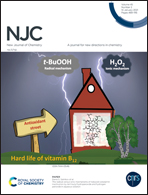Photocatalytic antifouling coating based on carbon nitride with dynamic acrylate boron fluorinated polymers†
Abstract
Based on the situation of marine biofouling and the ecological crisis caused by toxic antifouling paints, a series of environmental carbon nitride (C3N4) nanocomposite films (CNPs) were prepared by incorporating C3N4 into a self-polishing acrylate boron fluorinated polymer (ABFP). The antifouling performance was evaluated by the diatom anti-attachment test, photocatalytic antibacterial measurements and a mussel settlement assay. The results showed that the optimal content of C3N4 to inhibit the adhesion of diatoms was 3–7 wt%, the antibacterial rate of Staphylococcus aureus (S. aureus) and Escherichia coli (E. coli) reached 98.10% and 96.94% in the presence of 7 wt% C3N4 under irradiation with visible light for 90 min. In addition, the CNPs and ABFP showed an ability to expel mussels. As a synergistic effect, the self-renewable polymer surfaces could also strip the attached fouling organisms without light. The undifferentiated growth rates between the CNPs and blank proved the environmental properties of the prepared films. The chemical oxygen demand (COD) values showed that the addition of C3N4 contributed to the eco-friendly properties of the CNPs.



 Please wait while we load your content...
Please wait while we load your content...